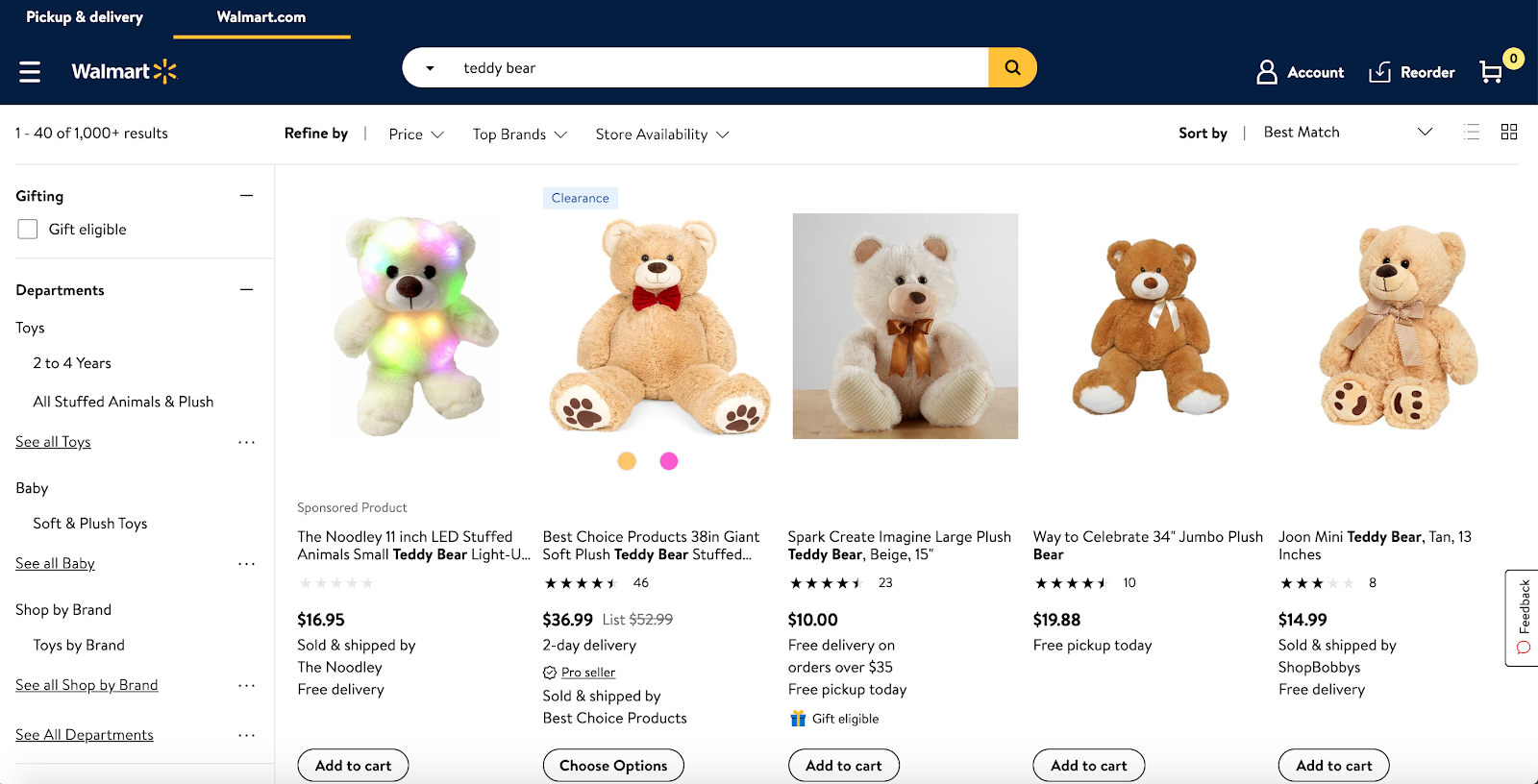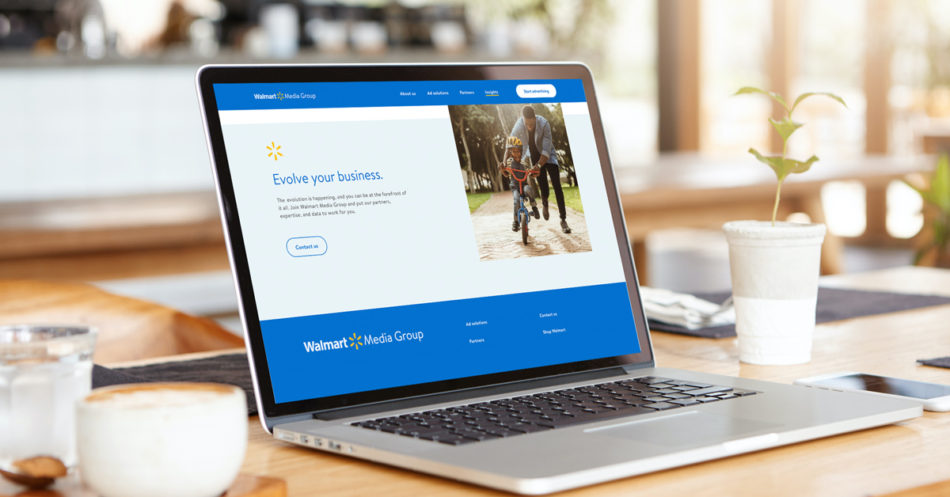Walmart Marketplace Advertising
Walmart provides advertising opportunities for marketplace sellers seeking to boost product awareness and increase conversions. The foundational Walmart ad type is Sponsored Products. Like its counterpart on Amazon, this is a keyword bidding type of ad, and it plays a critical role in your products’ discoverability on Walmart.
Let’s say a shopper goes to Walmart.com and enters “teddy bear” into the search bar. Any of the many brands and types of teddy bears sold on the marketplace are potential candidates for the search results page. Running a Sponsored Products ad for your teddy bear and bidding on the keyword “teddy bear” gives you a better chance to win a premium sponsored placement on that results page.

The text “Sponsored Product” above the description of the first teddy bear on this example of a Walmart search results page indicates that this bear is a sponsored placement.
Walmart’s First Price PPC Auction
Sponsored Products ads run on an auction system. Every seller that is running Sponsored Products against a given keyword is participating in this auction. Participating means bidding to win the ad placement when a shopper searches using a given keyword. Sponsored Products can appear in the search results grid, the carousel, or even on a product detail page.
Sponsored Products ads are a pay-per-click (PPC) ad type, which means you’ll only pay when a shopper clicks on them.
However, remember that paying for clicks means you’re spending each time the ad works well enough to drive a shopper to the product detail page. That doesn’t necessarily mean that clicks will lead to conversions.
Conversions are much more likely if the product is not only a good match for what the consumer searched for, but the product detail page has all the information a shopper needs to make an informed purchasing decision.
That means product titles, images, and descriptions need to be thorough and compelling. Pricing and shipping time need to be competitive. And of course, having a sizable number of good reviews can go a long way toward convincing a customer to buy. The item also needs to be categorized appropriately for the ad to render in the sponsored ad placements.
Use this retail readiness checklist to ensure your product page will give you the best possible chances of driving conversions through your advertising.
Walmart advertising alert:
In November 2020, Walmart Media Group announced two new Sponsored Products placements, creating more opportunities to place your products in front of shoppers.
New placement 1: Auto Sponsored Products for pickup & delivery products can now appear in personalized carousels. There’s a limit of ten Sponsored Products ads across carousels, and no more than two in each carousel.
New placement 2: Auto and manual Sponsored Products that aren’t eligible for Search In-Grid positions one to twelve can now appear in the search results page in the middle or bottom of the search grid. There is now a maximum of six Sponsored Product placements on page one, an increase from a previous max of only two.
Auto & Manual Campaigns
Walmart Sponsored Products ad campaigns come in two variations: auto and manual. Auto campaigns do not have keywords associated with them. Walmart’s algorithm uses your product listing and category information to make matches with customer search terms. Walmart doesn’t know what search terms will convert for your product, so the system will test out many. This means auto campaigns tend to run inefficiently.
On the other hand, auto campaigns can be great for discovering keywords that successfully connect shoppers to your products and lead to conversions. You may think you know how shoppers will look for your product, but people can surprise you with how they think about and look to use your product. Using auto campaigns can be a way to discover these keywords that you wouldn’t have thought of yourself. For example, a product that you designed as a piece of a uniform, but that you didn’t realize would also sell well as a costume piece near Halloween.
Manual campaigns are where we really dig in with keyword bidding strategy. Manual campaigns run based on the keywords that you put into them. Populate manual campaigns with terms that have performed well in auto campaigns. You can identify these terms by regularly downloading a search term report. It may also be worthwhile to test out keywords that perform on other marketplaces such as Amazon.
Walmart Keyword Bidding
At Teikametrics, we recommend creating a unique campaign for each item that you wish to advertise. Specifically, this means each base item, because Sponsored Products do not work for child items. The reason to put only one item into each campaign is to maximize your control over how you bid.
Within each campaign, create four ad groups to manage four different types of keywords: (1) generic, (2) brand, (3) competitor, and (4) marketplace.
Each ad group will include broad, phrase, and exact keyword match types. Exact keywords will most closely align with search terms whereas broad keywords allow for matches that are related but not identical.
Let’s look more closely at the four keyword types.
Generic
Generic terms describe a type of product or a solution to a problem. A shopper searching using a generic term has not yet identified a brand they wish to purchase. An example of a generic keyword could be “tennis racket.”
Generic keywords are important because the majority of marketplace searches start with this type of search. Bidding on generic keywords allows you to meet the customer where they are in their journey and draw them to your brand.
Brand
Brand keywords are the terms associated with your brand. “Sodastream” is an example of a brand term. A shopper who searches for this term isn’t just searching for any soda-making solution. They have a particular brand in mind. Be careful bidding on brand terms so you’re not cannibalizing sales you would have made organically. Focusing on brand terms is best understood as a defensive strategy.
Competitor
Competitor keywords are associated with other brands. Shoppers searching for these keywords have already identified a competitor as the answer to their purchase need. Bidding on these keywords allows you to conquest those competitors, especially if you can offer a superior product or a lower price to entice shoppers.
Marketplace
We use the term marketplace keywords to refer to the best performing keywords from other places where people are discovering your products, such as Amazon or Google. These keywords may or may not perform as well in Walmart’s unique ecosystem, so isolating them in their ad group enables you to test them, keep the ones that work, and stop using the ones that don’t work.
Adjust Keyword Bidding Based on Performance
Walmart keyword bidding is a process, not a destination. Start by setting goals for your campaigns. Knowing what you want to achieve will dictate KPIs and help you to hone in on the metrics that matter for your business. For newer products launching on the marketplace, you might be focused more on impressions and clicks. If your goal is profitability you’re more likely to give your attention to conversion rate and ROAS.
Regularly check to see if your ads are meeting your goals and if they’re not, adjust bidding strategies to improve performance. The marketplace is constantly changing so you need to use a consistent approach with the right tools to achieve profitable results.





